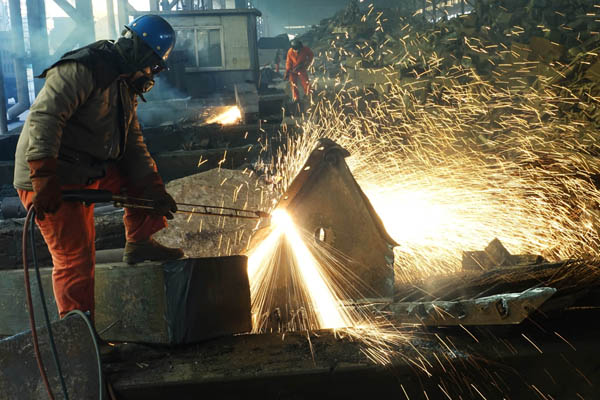China producer prices continue declines
(Xinhua) Updated: 2015-02-10 10:55
 |
|
A worker cuts the scrap metal at a factory in Dalian, Liaoning province, Dec 9, 2014. [Liu Debin / Asianewsphoto ] |
Deepening industrial deflation is difficult to curb in the short term, experts said, because the prices of raw materials, including oil and natural gas, may remain soft around the world.
Liu Ligang, chief economist in China at Australia and New Zealand Banking Group Ltd, said that the central bank is likely to cut required reserve ratios by year-end to curtail deflation risks.
"The weak PPI means Chinese enterprises are struggling amid the economic slowdown. Their profits will drop further as their debts surge," said Liu.
The People's Bank of China, the central bank, cut the benchmark interest rates in November. But the cuts were asymmetric, and deposit interest rates and interbank market rates remain high.
"That means the effect of the rate cuts is weak, and the central bank must cut the reserve ratio more than once to ensure that the monetary policy is effective," Liu said.
He forecast three RRR cuts of 50 basis points each in 2015.
Strong headwinds from the property market correction, overcapacity in upstream industries and high local government debt are the main causes of the slowdown.
"Increasing deflationary pressure in China will push up real interest rates and compel more rate cuts," said Wang Tao, chief economist in China at UBS AG.
"We expect at least two more cuts in benchmark lending rates totaling 50 basis points by end-2015, and we see the central bank continuing to provide sufficient liquidity to keep the money market rates low.
"Rate cuts are key in driving down debt service burdens, improving corporate cash flow and reducing financial risk by slowing the pace of nonperforming loan formation. We do not see these measures as having a significant stimulative impact on credit and GDP growth," she said.
- Richest Chinese helps carmakers turn to solar power
- Valentine's Day means business
- China to share development with countries along maritime Silk Road
- Shanghai FTZ relaxes overseas financing
- Yuan bond markets to grow in 2015: Moody's
- Standardization key for rehabilitating 'Made in China'
- Chinese use more credit cards in 2014
- Authority dismisses China telecoms merger rumors

















